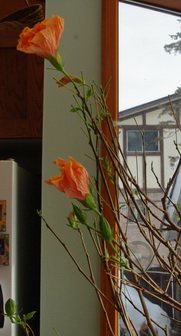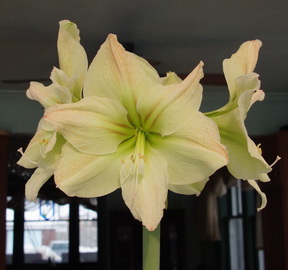


The snow is deep but the days are getting noticeably longer. If snow is the world’s best winter mulch then my garden should do really well this year. Will the Roses really retain viable canes two feet off the ground. There actually was life in the Rose canes at least a foot (30cm) above the ground this spring after last year’s near record snowfall. It was the first time I can remember pruning off some live wood when pruning the Roses. This is really good news for procrastinating gardeners who didn’t quite get around to hilling up their Roses last fall.  The saddest hibiscus you have ever seen is sitting in the corner of the solarium. There are almost no leaves left on it and yet the flower buds that were already formed before the spider mites defoliated it, continue to bloom. There are these bare sticks with lovely salmon coloured flowers at their ends. I will have to put it out its misery soon and give it its annual pruning.
The saddest hibiscus you have ever seen is sitting in the corner of the solarium. There are almost no leaves left on it and yet the flower buds that were already formed before the spider mites defoliated it, continue to bloom. There are these bare sticks with lovely salmon coloured flowers at their ends. I will have to put it out its misery soon and give it its annual pruning. I facetiously asked in the last issue of Dallying if there was a connection between lots of early snow and the early arrival of the dreaded spider mites. Apparently I shouldn’t have been so facetious. John, a reader, friend and biologist, wrote to tell me that his research has shown that there actually is a connection. The large expanses of clean white snow, reflect an increased intensity of light into the house and the spider mites react to the light intensity more then they do the length of the days. The best part of this newsletter is when we all, especially me, get to learn something new about this amazing pastime that we all enjoy. It is part of my job to report on gardens that I visit so that you might plan visits to them if you are thinking of travelling in those areas of the world. I have to now tell you about the great sacrifice that I am about to make, to live up to my part of that bargain. I’m forced to leave the snow and cold of my garden for five days with my Garden Writer’s group to tour some gardens in central Florida. I’ll report back to you what I have seen in the next issue of Dallying. It’s a tough job but somebody has to do it. Questions My newsletter subscribers get to ask me questions. Just ‘reply’ to the email newsletter. It is always interesting to read the questions; mostly to see if I actually can answer them or if I have to wade into the textbooks to research the answers. If that happens then we all learn something. Paul Asks? Which are the best cucumbers to grow to make Dill pickles, and which is the best seed for pickled onion making? Ken Answers! Your question about pickles just opens a can pickles. There are many pickling varieties of Cukes. If you want to make one large batch then choose a determinate type that fruits all at once; an indeterminate type will continue to produce all summer but in smaller quantities. How much space do you have. There are bush types, semi bush types and the regular vining types, which of course you can grow up a trellis to save space. If you are really fussy do you want green or black spined types. Answer those questions for your own garden and then peruse the seed catalogues for a variety that meets your requirements. There will be several to choose from. Take your time, Cucumbers don’t need to be started in doors until early May. Your Onion question is more pressing as they need to be started as soon as you can get your seed. Similar set of questions. Do you want small white pickled onions or larger brown/yellow types. There are so many varieties of Onions that I couldn’t give you a direct answer. If you want small pickles then plant them close together and that will help to give you a large yield of small Onions from a small space. 111 Trent St. W. Whitby ON L1N1L9 |
 I love to try new varieties and the
I love to try new varieties and the 